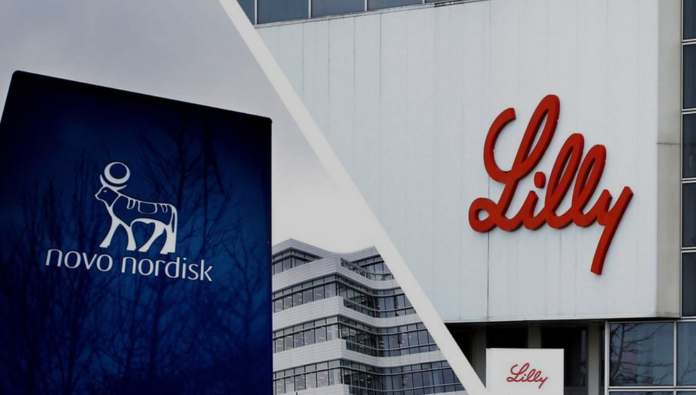Introduction
The race for dominance in the weight-loss drug market has seen significant competition between Novo Nordisk and Eli Lilly. Novo Nordisk, with its drug semaglutide, had an early lead. However, recent developments suggest that Eli Lilly’s tirzepatide might soon overtake its rival. This article delves into the dynamics of this competition, examining clinical efficacy, market trends, and strategic positioning.
Tirzepatide vs. Semaglutide: Clinical Efficacy
Promising Study Results
A recent observational study published in JAMA Internal Medicine indicated that Eli Lilly’s tirzepatide, marketed as Zepbound, resulted in greater weight loss in obese or overweight adults compared to Novo Nordisk’s semaglutide, known as Wegovy. Although head-to-head clinical trials are still required to confirm these findings, the preliminary data is promising for Lilly.
Analyst Insights
Evan Seigerman, a senior research analyst at the Bank of Montreal, stated, “I’ve known tirzepatide is better than semaglutide. It’s a stronger drug; you lose more weight on Zepbound. I don’t think that’s a shocker.” Louise Chen, managing director at Cantor Fitzgerald, echoed this sentiment, noting that clinical trial data for Zepbound has consistently outperformed Wegovy.
Market Trends and Projections
Early Market Leadership by Novo Nordisk
Novo Nordisk launched Wegovy for chronic weight management in 2021, quickly establishing a strong market presence. The weight-loss drug market is projected to reach $100 billion by 2030, making it highly lucrative. Wegovy’s approval and subsequent market success gave Novo Nordisk a significant head start.
Eli Lilly’s Rapid Ascendancy
Zepbound, approved by the FDA in November 2023, has swiftly gained traction in the market. Seamus Fernandez, an analyst at Guggenheim Securities, predicted that Zepbound could become the biggest drug of all time. Sales projections by Seigerman estimate Wegovy will generate $8.7 billion in the U.S. this year, compared to Zepbound’s $3.7 billion. However, by next year, Zepbound is expected to nearly match Wegovy’s sales at $12 billion, with Wegovy slightly ahead at $14 billion.
Physician Preferences and Prescription Trends
Favoring Zepbound
Chen observed that a majority of doctors prefer prescribing Zepbound. If the playing field were level in terms of price and supply, Zepbound would likely dominate. Indeed, for the first time in the first quarter of 2024, Zepbound prescriptions outpaced those of Wegovy, a trend anticipated to continue.
Supply Constraints and Manufacturing Efforts
Supply Challenges
Both Zepbound and Wegovy face significant supply constraints. In April 2024, the FDA’s drug shortage database indicated limited availability of Zepbound in the U.S. through the second quarter of 2024. Wegovy also faces shortages, with several dosage amounts in short supply due to high demand.
Manufacturing Investments
To address supply issues, both companies are ramping up manufacturing efforts. Eli Lilly is developing new facilities in the U.S. and Europe. Novo Nordisk is acquiring facilities from contract manufacturer Catalent to boost GLP-1 production, with the deal expected to close by the end of 2024. Seigerman noted that the supply situation is slightly better for Zepbound due to these investments.
Coverage, Pricing, and Market Dynamics
Insurance Coverage and Indications
Insurance coverage plays a crucial role in the market dynamics of weight-loss drugs. Positive clinical trial results for various indications, including heart failure, kidney disease, nonalcoholic steatohepatitis, and sleep apnea, could prompt more insurers to cover these drugs. This expanded coverage would significantly boost market share for both companies.
Socioeconomic Impact
Chen highlighted the importance of these drugs for socioeconomically disadvantaged populations, stating, “A lot of these populations are socioeconomically disadvantaged, so having one solution for four or five [health] problems is a huge deal.”
Pricing Pressure
Pricing is another critical factor in this competition. Novo Nordisk’s CFO, Karsten Munk Knudsen, acknowledged in a first-quarter earnings call that net pricing for Wegovy would decrease due to increasing volume and competition. This downward pricing trend is expected to continue throughout 2024. Seigerman noted that Novo is working to remain competitive with Zepbound on pricing.
Strategic Implications
Future Market Positioning
While Wegovy currently leads in sales, the trajectory suggests that Zepbound may overtake it within a few years. By 2027, Seigerman predicts Lilly will have the market edge. Strategic investments in manufacturing, pricing adjustments, and expanded indications will be crucial in determining the long-term leader in the weight-loss drug market.
Competitive Landscape
The intense competition between Novo Nordisk and Eli Lilly highlights the dynamic nature of the pharmaceutical industry. As both companies strive to address supply issues and secure broader insurance coverage, the market for weight-loss drugs will likely continue to evolve rapidly.
Conclusion
The competition between Eli Lilly and Novo Nordisk in the weight-loss drug market is fierce and evolving. While Novo Nordisk’s Wegovy has enjoyed early success, Eli Lilly’s Zepbound is poised to challenge and potentially overtake its rival. Factors such as clinical efficacy, supply constraints, insurance coverage, and pricing will play pivotal roles in shaping the future of this market. As both companies continue to innovate and adapt, the ultimate winner of this race remains to be seen.
